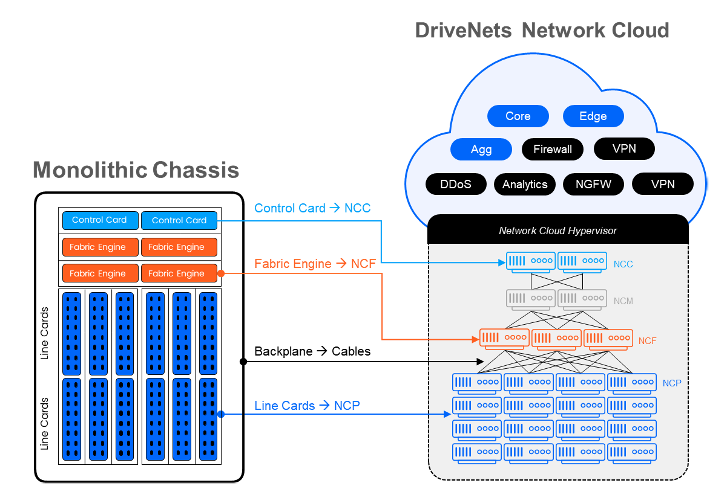Exploring Data Center Interconnect (DCI)
In the past decade, one of the most significant shifts has been the transition from traditional, centralized data center models to a more dispersed infrastructure. This change is driven by various factors, including the need to improve the customer experience, reduce costs, and increase resiliency. As a result, service providers (SPs) require interconnecting multiple data centers and allowing them to connect seamlessly.

DCI is the process of linking multiple data centers together to achieve business or IT objectives. This interconnection is typically achieved through high-capacity interfaces, including dedicated private lines, dark fiber, Ethernet, and internet-based connections.
With DCI, SPs can host critical functions as the networking environment supports data replication and redundancy, load balancing, and disaster recovery. Moreover, DCI plays a crucial role in enhancing application performance by enabling data centers to distribute workloads more efficiently and deliver the data closer to the origin.
Why Do We Need DCI?
In today’s data-centric world, DCI plays a pivotal role. Firstly, DCI addresses the growing demand for bandwidth by enabling high-capacity connectivity. It efficiently manages large data volumes, distributing them across various sites.
Secondly, DCI improves application performance. As SPs shift towards edge computing, there’s also a shift toward smaller, more numerous data centers distributed across various geographic locations. This design allows SPs and their business customers to experience faster, more reliable access to cloud environments, edge computing, and private data and applications nearer to their locations. As a result, SPs benefit from a more agile and flexible IT infrastructure.
Lastly, DCI is essential for maintaining service continuity. By interconnecting data centers, organizations can replicate data and applications across different sites. This is crucial for disaster recovery, ensuring that in the event of a failure, data and applications remain accessible from alternate locations.
What are the challenges for DCI
While DCI offers numerous benefits, it also comes with its own set of challenges:
- Performance: Performance is primarily affected by the two elements of distance and scale, both of which pose challenges. DCI links can span hundreds or even thousands of kilometers. Maintaining high bandwidth and adequate latency over such distances is challenging. The second element, scalability, is equally crucial. With the growing demand for more capacity, DCI solutions must scale accordingly to accommodate this growth without compromising performance.
- Cost: The cost factor associated with DCI cannot be overlooked. The expenses involved in establishing and maintaining a DCI infrastructure – including fiber optic cables, switching equipment, and data center space – can be significant. Furthermore, managing and monitoring DCI infrastructure requires extensive operational efforts.
- Security: Ensuring security and compliance across interconnected data centers is a challenge. DCI links are prime targets for cyberattacks. As such, maintaining data integrity and security becomes increasingly complex, especially when using internet-based connections. SPs and their business customers must implement robust security measures.
- Complexity: Establishing a seamless and efficient DCI link requires a deep understanding of varied hardware equipment and software solutions from various vendors. This heterogeneity makes management and troubleshooting challenging.
DriveNets and DCI
Service providers are looking for a DCI solution that meets their new business requirements. This includes connecting more distributed data centers with high capacity at a lower cost, while maintaining carrier-grade performance and robustness.
DriveNets Network Cloud is a networking solution designed to meet the needs of service providers in the rapidly evolving networking landscape. It disaggregates traditional hardware-centric routers into building blocks, with the control plane running on x86 servers and the data plane implemented as a cluster of multiple white boxes interconnected as one router using a Clos topology. The cluster is based on two main types of white boxes: the Network Cloud Packet Forwarder (NCP) and the Network Cloud Fabric (NCF).

Using DriveNets Network Cloud for a DCI solution brings several benefits to service providers. The first is enhanced scalability. DriveNets Network Cloud is highly elastic and can be scaled incrementally, one white box at a time, supporting clusters of up to 819TB.
The second is decreased costs. When it comes to distance and cost, DriveNets supports advanced link technologies like ZR+, enabling the use of high-capacity fiber layouts without external DWDM transponders. This approach not only boosts performance but also significantly reduces costs.

Another benefit is reduced complexity. Network cloud allows for the cluster to be operated as one single router with one CLI regardless of its size. Furthermore, since the solution is software-centric, new features and services can be introduced much faster.
Finally, high availability is another benefit provided by DriveNets Network Cloud. For SPs, DCI connectivity is not just a technical enhancement but a potential revenue generator. As a result, service availability is something that should be the cornerstone of the solution. DriveNets Network Cloud is a proven carrier-grade solution that powers the world’s largest software-centric network. The solution has been deployed successfully by tier-1 service providers in North America, India, Japan and Europe.
Why DCI is a vital for modern network infrastructure
DCI represents a vital component in the modern network infrastructure, facilitating improved data management, enhanced application performance, and robust service availability. With the trend of shifting more resources and capabilities to the edge, the role of DCI is even more critical, necessitating ongoing innovation and strategic planning to fully leverage its potential. Successful DCI solutions can be key for unlocking the potential of networks in the new digital age





